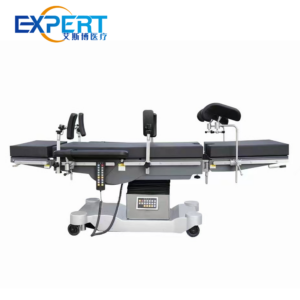Dirección
304 North Cardinal St.
Dorchester Center, MA 02124
Horas laborales
Lunes a viernes: 7:00 a. M. - 7:00 p. M.
Fin de semana: 10 a. M. - 5 p. M.
In the ever-evolving landscape of medical technology, surgical procedures have become increasingly complex and specialized. To meet the demands of these intricate procedures, surgical tables have undergone a significant transformation. One of the key innovations that have revolutionized surgical tables is the integration of adjustable positions. This article delves into the pivotal role that adjustable positions play in modern surgical tables and their impact on surgical precision, patient outcomes, and procedural efficiency.

Surgical tables have come a long way from their humble origins as basic platforms for patient placement during procedures. Early surgical tables lacked the versatility required to accommodate the diverse range of surgical techniques and specialties that exist today. Surgeons faced challenges in achieving optimal patient positioning, leading to increased risks and reduced procedural success rates.
Adjustable positions in modern surgical tables have unlocked a new dimension of surgical precision. Surgeons can now manipulate the table’s height, tilt, lateral tilt, and Trendelenburg positions with remarkable accuracy. This adjustability is particularly crucial in procedures that demand precise anatomical alignment and access, such as orthopedic surgeries, neurosurgeries, and cardiovascular interventions.
Different surgical procedures require different patient orientations. For instance, a cardiac surgery might necessitate a Trendelenburg position to ensure optimal access to the heart, while a spinal surgery could benefit from a lateral tilt for enhanced spinal alignment. The ability to tailor the table’s position to the specific requirements of each procedure minimizes complications, reduces procedural duration, and enhances patient safety.
Incorporating adjustable positions in surgical tables extends beyond patient comfort—it also revolutionizes intraoperative imaging. Radiolucent tabletops, coupled with adjustable positions, allow for uninterrupted imaging during procedures that require fluoroscopy, X-rays, or other imaging modalities. Surgeons can maintain the desired patient position while obtaining accurate real-time images, eliminating the need for frequent repositioning and streamlining the surgical workflow.
Surgical procedures can be physically demanding, often requiring surgeons to maintain specific postures for extended periods. Adjustable positions address this challenge by enabling surgeons to customize the table’s orientation to their own comfort and ergonomic needs. This ergonomic adaptability reduces surgeon fatigue, allowing them to focus on the intricate details of the procedure without compromising their well-being.
Every patient is unique, and their anatomical characteristics vary. Adjustable positions empower surgical teams to tailor the table’s configuration to the patient’s specific requirements. This customization is especially valuable in cases involving pediatric patients, elderly individuals, or patients with complex medical conditions. Surgeons can ensure optimal patient positioning, enhancing surgical success rates and minimizing post-operative complications.

Adjustable positions contribute to procedural efficiency by minimizing the time required for patient positioning. Surgeons can quickly transition from one position to another, reducing intraoperative delays and ensuring a seamless surgical workflow. This efficiency is particularly critical in emergency procedures where time is of the essence.
As technology continues to advance, the potential for adjustable positions in surgical tables expands further. Integration with robotics, artificial intelligence, and augmented reality could lead to automated positioning adjustments based on real-time procedural data. Surgeons might soon find themselves working in tandem with intelligent systems that optimize patient positioning for the best possible outcomes.
Q1: Can adjustable positions be beneficial for all types of surgical procedures?
A1: Yes, adjustable positions are beneficial for a wide range of surgical procedures, as they allow surgeons to achieve precise patient orientations tailored to the specific requirements of each procedure.
Q2: How do adjustable positions enhance imaging during surgery?
A2: Adjustable positions, coupled with radiolucent tabletops, enable uninterrupted imaging by maintaining patient positioning while obtaining accurate real-time images.
Q3: Are adjustable positions only beneficial for surgeons?
A3: No, adjustable positions benefit both surgeons and patients. Surgeons experience reduced fatigue, while patients benefit from optimized positioning that enhances surgical outcomes and reduces post-operative complications.
Q4: What is the potential impact of technology on adjustable positions in the future?
A4: Technology could automate adjustable positions through robotics and artificial intelligence, leading to even more precise and efficient patient orientations based on real-time procedural data.
Adjustable positions have transformed surgical tables from static platforms into dynamic tools that contribute to surgical precision, patient safety, and procedural efficiency. The ability to customize patient orientations according to the specific demands of each procedure has revolutionized modern surgery, enhancing imaging, surgeon comfort, and overall surgical outcomes. As technology continues to propel the field of medicine forward, the role of adjustable positions in surgical tables is poised to evolve, ensuring that the delicate dance between medical expertise and technological innovation continues to yield remarkable results.
